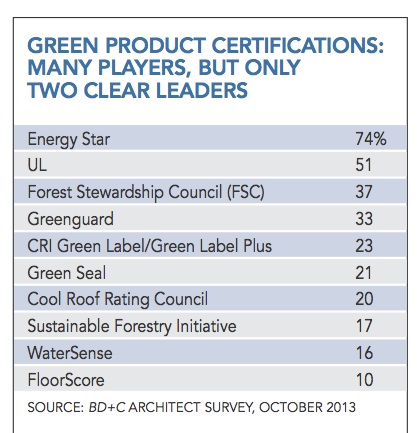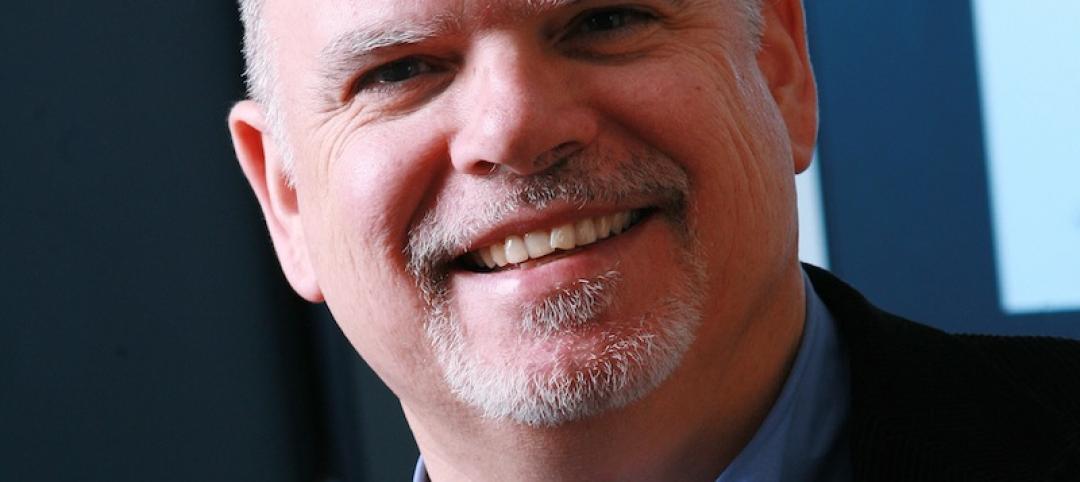LEED, though controversial, still dominates the world of sustainability rating systems. Photovoltaics and geothermal are gaining traction in high-performance projects. And many firms don’t push clients very hard toward sustainability certification.
These are among the findings of an exclusive survey of BD+C readers in the architecture sector, conducted in October. More than 150 architects, mostly from the U.S., responded with data about their sustainable design practices. Since respondents were self-selected, it’s likely that they have more than a casual interest in the topic—as evidenced by the intensity of some of their comments. Though based on a sizable number of responses, results should be viewed as a snapshot rather than a statistically valid random sample.
In particular, the survey indicates that architects are seeking affirmation that the complex array of programs, systems, and tools at their disposal actually do result in more sustainable buildings. They want real value rather than—in the words of one respondent—“a lot of green bologna.”
Through all the changes, LEED still leads
Fifteen years after its birth, LEED remains powerful, with 64% of respondents saying they have used the program to register or certify projects in the past 12 to 18 months. Energy Star for buildings is also fairly popular (28%). Usage of every other green-rating program we asked about was in the single digits, including Green Globes (8%), the National Green Building Standard (8%), the Living Building Challenge (6%), BREEAM (4%), and the Collaborative for High Performance Schools (2%).
Respondents have widely varied practices when it comes to client discussions about green rating systems. Only 3% said they routinely seek the highest possible certification level for all projects. A majority (62%) either don’t push their clients or let clients lead.
The familiar “we’re green but not certified” refrain was shared by a high percentage of respondents. Nearly 25% said more than half of their projects achieve a fairly high level of sustainability (at least LEED Silver or equivalent) but do not complete green certification of any kind. Another 27% of respondents said that 25 to 49% of their work falls into the “green but uncertified” category. The remaining respondents said that less than 25% of their work is “highly sustainable but uncertified.” (This answer may include responses from those who are doing some “green but uncertified” work, as well as responses from those whose work is not highly sustainable, period.)
The cost and complexity of LEED prompted a fair amount of spontaneous commentary. “The ever-evolving LEED standards threaten to make them irrelevant in the face of more practical and readily understood design and construction programs,” said one reader. Another characterized the cost of long-term recertification requirements as “unsustainable.” (Nevertheless, about two-thirds of our respondents have continued to use the program.)
Green-rating systems, whatever their pros and cons, still represent a useful sustainability framework for many Building Teams and owners. To better understand architect-client interactions involving this issue, we asked respondents to select one of five statements reflecting their firms’ typical engagement levels with rating systems—from habitual to minimal (Figure 1).
Ready for v4? Not so much
We asked architects about their individual and firm-level involvement with LEED v4, still in its infancy. Though fewer than 10% of respondents’ firms had participated in a v4 beta project or currently have a v4 project under way, 27% of respondents had taken the initiative to view a v4 webinar. Other individual activities include downloading the user guide (19%) and attending a related lunch-and-learn (12%) or USGBC chapter program (10%). However, 35% of respondents said they have taken no individual action to gear up for v4, and 45% said their firms have not taken action.
LEED v4 represents a major revision, not just a tweak, and pushback emerged in numerous comments. “I am concerned that a great many of the LEED credits are becoming so labor-intensive that the cost to the client for certification services will be prohibitive,” said one respondent. “The amount of detail on materials content and so on will require the design firm to hire an outside specialist or create an in-house position specifically for that task, pricing actual certification above the reach of more common projects.”
The long-term measurement and recertification aspects of the program are also a concern for some architects. “Adding this burden to the design profession via certification programs or building codes is asking architects to be responsible for actions outside their skill set,” said one respondent.
Another reader, who termed v4 “a big challenge,” continues to support efforts to refine the standard. “I hope that the changes don’t cause owners to give up on LEED. Passing LEED v4 was important; LEED must continue to be a leader in the world of green building.”
“We don’t push certification unless the client specifically brings it up” was the most popular response (36%), followed by “We encourage clients to pursue certification but let them take the lead” (26%) and “We pursue all projects to at least a minimum level, whether or not the client requests it” (21%). Only 14% of respondents said they “actively encourage clients to pursue certification, and challenge them to consider the highest possible certification levels.”
One respondent said, “I see the trend as expecting professionals to design to a specific sustainability goal, but not to spend precious money certifying.”
Even as LEED continues to evolve, it remains voluntary. Not so with several new green standards (or major revisions) that are likely to be incorporated in building codes. We asked readers how the International Green Construction Code, the 2012 International Energy Conservation Code, and ASHRAE Standard 90.1-2013 would affect their practice. Sixty-three percent of respondents predicted “some changes,” while 29% said there will be little immediate impact—in other words, business as usual. However, 8% expected the new standards to cause significant changes in their practice.
One respondent who derided certification as “useless P.R.” was more enthusiastic about these consensus standards, saying “code requirements and common sense will make the profession work toward better, more efficient buildings.”
Venerable labels trusted for sustainable products
Product selection is an important aspect of sustainable design. We asked respondents which of 15 green-product certification systems they use most often in their daily work. The time-honored Energy Star (74%) and UL (51%) ratings were by far the most frequently chosen. Forest Stewardship Council (37%) and Greenguard (33%) certification are also fairly popular (Figure 2).
Greenbuild coverage of Architecture Firms is brought to you by:
Many architects are increasingly concerned about the potential environmental and health impacts of the products they specify. Environmental product declarations and health product declarations are at least “somewhat important” to more than 50% of respondents, with 11% terming them “extremely important.” However, 23% said they’re unfamiliar with EPDs and HPDs.
“I feel that healthy building materials will be the biggest transformation in the industry for the near future,” said one respondent. “This will be driven in the industry by LEED v4, but also, a general awareness of harmful substances has taken hold. Look at the new ingredient transparency policies being put into place by Walmart and Target. As designers, what liability do we incur with the knowledge that comes with material transparency?”
Net-zero and beyond
Some Building Teams and owners no longer see “sustainable” as a big enough goal. Instead, they’re striving for high-performance buildings that have minimal detrimental effects on the environment and maximum benefits for occupants. A dizzying array of targets exists, including net-zero energy, net-zero water, net-zero waste, net-plus, net-zero-ready, and zero-net-energy.
Of 15 green-product certification systems, Energy Star was the most popular, used frequently in daily work by nearly three-fourths of respondents. Five of the systems (BIFMA and ANSI/BIFMA, Cradle to Cradle, NSF Environmental Claims Initiative, Pharos Project, and Scientific Certification Systems) were used by fewer than 10% of respondents.
About 80% of respondents said they have not yet done any projects in such a high performance category. The remainder said they’ve done one or two, with only a couple saying they’ve tackled more than five. “The buzz is net-zero, but I think it’s a long way off from becoming universal or easy to obtain,” said one respondent.
In most cases, a combination of advanced strategies is required to get to net-zero, or anywhere close. Technologies once considered cutting-edge have now become commonplace—especially high-efficiency HVAC, water-conserving plumbing, and daylighting—and architects are exploring new tactics.
Figure 3 summarizes the relative popularity of emerging technologies. Roof-mounted photovoltaics were the clear winner, with 46% of respondents saying they’d used them on a project in the past 12 to 18 months. Also popular are geothermal (43%), demand-controlled ventilation (35%), and advanced cladding systems (33%). The relative lack of consensus around most emerging technologies may reflect climate and project-type differences, as well as respondents’ lack of familiarity with some technologies.
According to one respondent, techniques for making the building envelope more efficient are “coming to the forefront” in green design, abetted by code changes. “We are already seeing maximum air infiltration values in the IECC 2012 energy code, and the concept is now ingrained in the IgCC as well. Whole-building air-infiltration testing and extra scrutiny on construction techniques and tightness to the envelope will become the norm.”
Several respondents see renovation and O&M as priorities for a more sustainable built environment. “The systems and products that apply to new buildings usually are not applicable to existing structures, especially those with historic value,” said one reader. “This is a challenge for owners, designers, engineers, and manufacturers.”
Another said, “We need to embrace the notion of controlling the implementation of energy strategies, rather than pushing that task off to the MEP engineers or ESCOs. Mastery of energy-modeling tools can put the architect in the lead as the strategist for energy retrofits, and hopefully result in holistic improvements.”
Of 16 “advanced” green strategies used by respondents in the past 12 to 18 months, roof-mounted PV systems and geothermal were the most popular. Passive ventilation, an old principle, is making a comeback.
Related Stories
| Dec 18, 2013
How small architectural firms can make big money
What separates the great-but-struggling designers from the great-successful ones isn't luck. If you're as good an architect as you think, it will take more than your awesome design skills to become successful. Learn how to manage your firm’s finances and go from floundering to flourishing.
| Dec 18, 2013
Architecture Billings Index takes step back in November
After six months of steadily increasing demand for design services, the Architecture Billings Index paused in November, dipping below 50 for just the second time in 2013.
| Dec 17, 2013
'Silver tsunami,' restaurant boom, mid-rise mania among predicted Midwestern construction trends
According to some of the Chicago-area’s top commercial real estate firms, informally polled by area real estate PR firm Taylor Johnson, much of 2013 was spent preparing for an even busier 2014. Given the relocation of many top companies to downtownChicago, demand for new apartments, office, retail and restaurant projects in 2014 should all be up as workers look to achieve a live, work and play lifestyle.
| Dec 17, 2013
NREL, National Trust offer energy roadmap for small buildings and small portfolios
The National Renewable Energy Laboratory and the National Trust for Historic Preservation’s Preservation Green Lab initiative have released the report “Industry Research and Recommendations for Small Buildings and Small Portfolios,” analyzing untapped opportunities in energy savings.
| Dec 17, 2013
Nation's largest net-zero K-12 school among winners of 2013 Best of Green Schools award
The Lady Bird Johnson Middle School in Irving, Texas, was named a winner of USGBC's annual award, along with nine other schools, individuals and communities working toward the common goal of healthy, high-performing learning places.
| Dec 17, 2013
BBG-BBGM joins HOK to create one of the world’s leading hospitality design firms
HOK, a global design, architecture, engineering and planning firm, announced today that architecture and interior design firm BBG-BBGM's New York and Shanghai employees have joined the company.
| Dec 17, 2013
IBM's five tech-driven innovation predictions for the next five years [infographics]
Smart classrooms, DNA-based medical care, and wired cities are among the technology-related innovations identified by IBM researchers for the company's 5 in 5 report.
| Dec 17, 2013
Kahn appoints Alan Cobb President and CEO
Cobb is the tenth president in the firm’s 118-year history. As President, Cobb is responsible for ensuring that all of the firm’s client issues are effectively address and that overall project team performance meets or exceeds client expectations for each and job the firm undertakes.
| Dec 17, 2013
CBRE's Chris Bodnar and Lee Asher named Healthcare Real Estate Executives of the Year
CBRE Group, Inc. announced today that two of its senior executives, Chris Bodnar and Lee Asher, have been named Healthcare Real Estate Executives of the Year by Healthcare Real Estate Insights.
| Dec 16, 2013
NASCC: The Steel Conference presents special seismic sessions
Twenty years ago the Northridge Earthquake shook California and the results surprised designers throughout the U.S. AISC and the steel industry is presenting a special series of sessions at the 2014 NASCC: The Steel Conference examining the lessons learned and the state-of-the-art in seismic design.



















